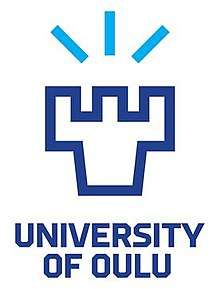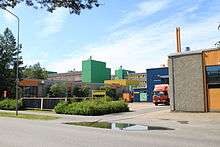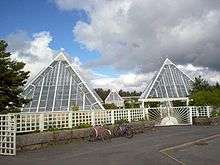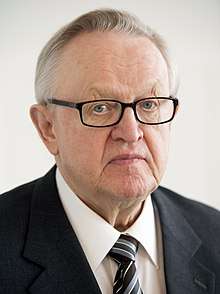University of Oulu
|
Oulun yliopisto | |
 | |
| Latin: Universitas Ouluensis | |
| Type | Public |
|---|---|
| Established | 1958 |
| Rector | Jouko Niinimäki |
Administrative staff | 2,868 (2010)[1] |
| Students | 15,880 (2010) |
| Location |
Oulu, Finland 65°03′33″N 025°27′58″E / 65.05917°N 25.46611°ECoordinates: 65°03′33″N 025°27′58″E / 65.05917°N 25.46611°E |
| Affiliations | Compostela, EUA, UArctic |
| Website | www.oulu.fi |



The University of Oulu (Finnish: Oulun yliopisto) is one of the largest universities in Finland, located in the city of Oulu. It was founded on July 8, 1958. The university has around 16,000 students and 3,000 staff. The university is often ranked as one of the better universities in Finland and in the top-400 worldwide.[2] [3]
History
- 1919 Oulu College Association was founded to manage the establishment of a university in the town
- 1958 Oulu University Act
- 1959 Activities begin. Faculty of Philosophy (programs in biology and mathematics), Faculty of Technology (architecture, civil and industrial engineering) and Oulu Teaching School
- 1960 Faculty of Medicine
- 1965 Teaching begins in humanities
- 1965 Departments of Electrical Engineering and Machine Engineering added to the Faculty of Technology
- 1972 The Faculty of Humanities and the Faculty of Natural Sciences founded with the division of the Faculty of Philosophy
- 1974 Faculty of Education
- 1985 Professorship in Telecommunications Technology established at the Faculty of Technology
- 1994 Biotechnology, Information Technology and Northern Issues defined as focus areas
- 2000 Founding of the Faculty of Economics and Business Administration
- 2006 Micro- and Nanotechnology Centre
- 2007 Oulu Mining School
- 2008 Martti Ahtisaari Institute of Global Business and Economics
- 2009 Center for Internet Excellence (CIE)
- 2010 New University Act, new focus areas
- 2011 Center of Microscopy and Nanotechnology founded by joining the Micro- and Nanotechnology Centre and the Institute for Electron Microscopy
- 2011 University of Oulu Graduate School (from 1.8.2011)
- 2014 Faculty of Biochemistry and Molecular Medicine (from 1.1.2014)
- 2014 Faculty of Information Technology and Electrical Engineering (from 1.1.2014)
- 2014 Oulu School of Architecture (from 1.1.2014)
Campuses
There are four campus areas:
- The main campus is located in Linnanmaa, about 5 kilometres (3 mi) north of Oulu city centre. It includes five faculties, Infotech Oulu, Thule Institute, Giellagas Institute, Martti Ahtisaari Institute, Centre for Wireless Communications (CWC), Centre for Advanced Steel Research (CASR), Center of Microscopy and Nanotechnology, Botanical Gardens and Museum, Zoological Museum, Geological Museum and two science libraries (Pegasus and Tellus).
- Faculty of Medicine has its own campus area and it is fully integrated in the regional hospital 2 kilometres (1.2 mi) southeast from the city center, Kontinkangas, Oulu. Clinical Research Centre (CRC), Welltech Oulu and the Medical Library are also located there.
- The third campus area is located in Kajaani, about 185 kilometres (115 mi) southeast of Oulu.
- Department of Architecture which is located in the center of Oulu
The University has a number of research stations and shared locations, most notably:
- Kajaani University Consortium
- Sodankylä Geophysical Observatory
- Oulanka Biological Research Station (Kuusamo)
- Bothnian Bay Research Station on Ulkokrunni island
- Oulu Southern Institute (Nivala), Centre for Underground Physics in Pyhäsalmi
- Kokkola University Consortium Chydenius
- Raahe Unit
Faculties
The University of Oulu is divided into ten faculties:
Faculty of Education (FEdu)
Faculty of Information Technology and Electrical Engineering (ITEE)
Faculty of Science (FSci)
Faculty of Medicine (FMed)
- Institute of Biomedicine
- Institute of Diagnostics
- Institute of Dentistry
- Institute of Clinical Medicine
- Institute of Health Sciences
Faculty of Technology (FTech)
- Chemical Process Engineering
- Control Engineering
- Energy and Environmental Engineering
- Environmental and Chemical Engineering
- Fibre and Particle Engineering
- Industrial Engineering and Management
- Machine Design
- Materials Engineering and Production Technology
- Mechatronics and Machine Diagnostics
- Process Metallurgy
- Structures and Construction Technology
- Sustainable Chemistry
- Systems Engineering
- Water Resources and Environmental Engineering
Oulu Business School (OBS)
- Management & International Business
- Economics
- Accounting
- Marketing
- Finance
- Martti Ahtisaari Institute of Global Business and Economics
- Full-time MBA Programme
Oulu Business School is accredited by AACSB International
Oulu School of Architecture (OSA)
International Cooperation
University of Oulu aims to promote mobility among its students. It takes part in a number of international exchange programmes, such as Erasmus Programme (Europe), Nordplus (Nordic Countries), FIRST (Russia), ISEP and International to International ISEP (USA, South America, Asia), UNC-EP (USA), north2north (USA, Canada, Russia, Nordic Countries), North-South-South (Africa). Besides, University of Oulu has about 50 bilateral agreements with partner universities around the world.
Research
University works in 70 research areas.[4] At the same time, four focus research areas are:[5]
- Information Technology (Machine vision and ubiquitous computing technologies, Wireless communications, High-speed electronics and photonics, Biomedical engineering, Information systems and software)[6]
- Biosciences and Health (Cell-extracellular matrix research, Cardiovascular disease research, Enzyme structure and metabolic research, Genes and the environment)
- Cultural Identity and Interaction (Cultural Identity and Interaction; Language, education and interaction)
- Environment, Natural Resources and Materials (Environmental issues, natural resources and energy economy; materials science, properties and behaviour of matter, catalysts and material innovations; modelling and computational science)[7]
New initiatives involve advanced steel research, international business, mining and mineral engineering and science-based education.
Notable alumni

- Martti Ahtisaari, M.Sc., former President of Finland, Nobel Peace Prize laureate (2008)[8]
- Jarkko Oikarinen, D.Sc., the developer of Internet Relay Chat (IRC)
- Leena Palotie, D.Sc., professor, geneticist[9]
- Jussi Pesonen, M.Sc. (Tech.), CEO of UPM-Kymmene Oyj
- Sakari Orava, D.Sc., professor, surgeon specializing in sports related injuries. Famous for operating surgeries on many top athletes such as David Beckham.
- Lasse Lehtinen, Ph.D., former Member of the Finnish Parliament and former Member of the European Parliament.
- Pekka Aikio, M.A. (Bio), president of the Sami Parliament of Finland for three terms from 1996 to 2008.
- Tytti Isohookana-Asunmaa, Ph.D. Finnish Minister of Culture (1991-1995), member of the Finnish parliament, from the Centre Party (1983).
- Tuija Lehtinen, B.Sc., (Stat.), writer, freelance author. Known for Mirkka, Laura and Janne novel series, chief scriptwriter of The Dibidogs animation series.
- Sami Lopakka, M.A. musician and writer, one of two guitarists for the band Sentenced (1989-2005).
- Hannu Rajaniemi B.Sc. (Math), author of science fiction and fantasy. Known novel, The Quantum Thief.
- Ago Silde M.A., Estonian politician, governor of Ida-Viru County 2004-2007.
- Jari Vilén M.A., politician and a diplomat, served in the Finnish Parliament, representing the National Coalition Party and the district of Lapland(1999–2007).
- Sauli Vuoti Ph.D.(Chem), musician, chemist, and freelance writer, vocalist and guitarist of the band Kinetik Control, founder of Inferno magazine.
University of Oulu alumni body is over 40,000.
Student services
Student Union of the University of Oulu[10] (Finnish: Oulun yliopiston ylioppilaskunta; OYY) provides services to and supervises the interests of all undergraduate degree students in the University of Oulu. All bachelor's and master's degree students in the University of Oulu belong to the Student Union. By paying the Student Union membership fee students are entitled for a student card which allows them to get student services and discounts. This way, students get inexpensive or free medical and dental care from Finnish Student Health Services,[11] (Finnish: Ylioppilaiden terveydenhoitosäätiö; YTHS) traveling discounts in trains and buses, student meals reduction etc.
There are a number of students organizations or so called student guilds[12] presented within the university.
Student housing
Student Housing Foundation of Northern Finland[13] (Finnish: Pohjois-Suomen opiskelija-asuntosäätiö; PSOAS) is the leading provider of student accommodation in Oulu. The organization operates on a foundation basis which ensures affordable rents for students. Following its mission, PSOAS offers housing services for people studying in Oulu as cheaply as possible. The residents of PSOAS houses in different areas around the city elect tenant committee for that area, which e.g. organises different activities, maintains club rooms and does other related issues, depending on the active members.[14]
The new international student house, named Aurora, was built next to PSOAS housing office in downtown Oulu. The building was finished during the spring of 2013. The house is supposed to be accommodated both by international degree students and Finnish students. The main purpose of the new building is to support the internationalization of Oulu and give the international students a better access to Finnish culture and local people. The premises will also support these efforts: More space is dedicated for casual get-togethers, as there is a lounge space on every floor and a café of high level will be serving both Finnish and foreign customers on the ground floor.[15][16]
Rectors
| Vuosi | |
|---|---|
| Jouko Niinimäki | 2015– |
| Lauri Lajunen | 1993–2015 |
| Juhani Oksman | 1990–1993 |
| L. Kalevi Korhonen | 1987–1990 |
| Markku Mannerkoski | 1968–1987 |
| Erkki Koiso-Kanttila | 1965–1968 |
| Niilo Söyrinki | 1963–1965 |
| Pentti Kaitera | 1959–1962 |
See also
References
- ↑ http://www.oulu.fi/english/annualreports
- ↑ "Academic Ranking of World Universities 2009". Shanghai Jiao Tong University. Archived from the original on 2013-03-23. Retrieved 2010-06-21.
- ↑ "THE - QS World University Rankings". QS Quacquarelli Symonds Limited. Retrieved 2014-12-30.
- ↑ "University of Oulu – An international scientific community known for high-quality research and education". Innovation Europe. Archived from the original on 2011-07-26. Retrieved 2010-06-22.
- ↑ "University of Oulu – Research focus and development areas". Archived from the original on 2013-05-13. Retrieved 2012-10-23.
- ↑ "Oulu UBI Screens Attract Anthropologists". 65degreesnorth. Retrieved 2010-06-22.
- ↑ "How many expats does it take to change a light bulb?". 65degreesnorth. Retrieved 2010-06-22.
- ↑ "Martti Ahtisaari wins Nobel Peace Prize". Oulu: University of Oulu. 10 October 2008. Archived from the original on 4 December 2010. Retrieved 21 June 2010.
- ↑ "Obituary: Professor Leena Peltonen-Palotie, Academician of Science". Oulu: University of Oulu. 12 March 2010. Retrieved 21 June 2010.
- ↑ Student Union of the University of Oulu Archived 2010-07-03 at the Wayback Machine.
- ↑ Finnish Student Health Services Archived 2010-07-09 at the Wayback Machine.
- ↑ "Student Guilds and Organisations in the University of Oulu". Oulu: Student Union of the University of Oulu. 2 July 2009. Archived from the original on September 25, 2010. Retrieved 4 October 2010.
- ↑ Student Housing Foundation of Northern Finland
- ↑ "Archived copy". Archived from the original on 2013-08-13. Retrieved 2013-07-16.
- ↑ "Accommodation". Oulu: University of Oulu. Retrieved 21 June 2010.
- ↑ "Archived copy". Archived from the original on 2013-06-29. Retrieved 2013-07-16.
External links
| Wikimedia Commons has media related to University of Oulu. |